| Listing 1 - 10 of 10 |
Sort by
|
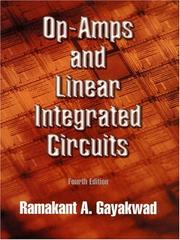
ISBN: 0132808684 9780132808682 Year: 2000 Publisher: Upper Saddle River (N.J.): Prentice Hall,
Abstract | Keywords | Export | Availability | Bookmark
 Loading...
Loading...Choose an application
- Reference Manager
- EndNote
- RefWorks (Direct export to RefWorks)
Operational amplifiers. --- Linear integrated circuits. --- Operational amplifiers --- Linear integrated circuits --- Amplificateurs opérationnels --- Circuits intégrés linéaires --- Amplificateurs opérationnels. --- Circuits intégrés linéaires. --- Amplificateurs opérationnels. --- Circuits intégrés linéaires.
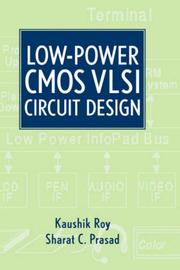
ISBN: 047111488X Year: 2000 Publisher: New York (N.Y.) : Wiley,
Abstract | Keywords | Export | Availability | Bookmark
 Loading...
Loading...Choose an application
- Reference Manager
- EndNote
- RefWorks (Direct export to RefWorks)
Integrated circuits --- Low voltage integrated circuits --- Metal oxide semiconductors, Complementary --- Very large scale integration --- Design and construction. --- Circuits intégrés à faible consommation --- Circuits intégrés à très grande échelle --- MOS complémentaires --- Design and construction --- conception et construction --- conception et construction. --- Circuits intégrés à faible consommation --- Circuits intégrés à très grande échelle --- MOS complémentaires
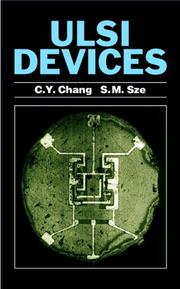
ISBN: 0471240672 Year: 2000 Publisher: New York (N.Y.) : Wiley,
Abstract | Keywords | Export | Availability | Bookmark
 Loading...
Loading...Choose an application
- Reference Manager
- EndNote
- RefWorks (Direct export to RefWorks)
A complete guide to current knowledge and future trends in ULSI devices Ultra-Large-Scale Integration (ULSI), the next generation of semiconductor devices, has become a hot topic of investigation. ULSI Devices provides electrical and electronic engineers, applied physicists, and anyone involved in IC design and process development with a much-needed overview of key technology trends in this area. Edited by two of the foremost authorities on semiconductor device physics, with contributions by some of the best-known researchers in the field, this comprehensive reference examines such major ULSI devices as MOSFET, nonvolatile semiconductor memory (NVSM), and the bipolar transistor, and the improvements these devices offer in power consumption, low-voltage and high-speed operation, and system-on-chip for ULSI applications. Supplemented with introductory material and references for each chapter as well as more than 400 illustrations, coverage includes:* The physics and operational characteristics of the different components* The evolution of device structures the ultimate limitations on device and circuit performance* Device miniaturization and simulation* Issues of reliability and the hot carrier effect* Digital and analog circuit building blocks
Integrated circuits --- Semiconductors --- Crystalline semiconductors --- Semi-conductors --- Semiconducting materials --- Semiconductor devices --- Crystals --- Electrical engineering --- Electronics --- Solid state electronics --- ULSI circuits --- Ultra large scale integration of circuits --- Ultra large scale integration. --- Materials --- Semiconductors. --- Circuits intégrés à ultra-grande échelle --- Semiconducteurs --- Ultra large scale integration --- Circuits intégrés à ultra-grande échelle. --- Semiconducteurs. --- Circuits intégrés à ultra-grande échelle.
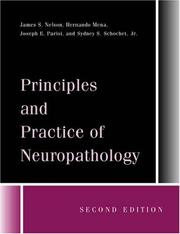
ISBN: 0195125843 9780195125849 Year: 2000 Publisher: New York (N.Y.) : Oxford university press,
Abstract | Keywords | Export | Availability | Bookmark
 Loading...
Loading...Choose an application
- Reference Manager
- EndNote
- RefWorks (Direct export to RefWorks)
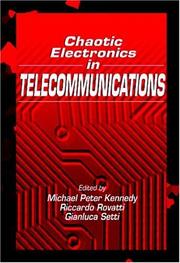
ISBN: 0849323487 Year: 2000 Publisher: Boca Raton, FL : CRC Press [Chemical Rubber Company],
Abstract | Keywords | Export | Availability | Bookmark
 Loading...
Loading...Choose an application
- Reference Manager
- EndNote
- RefWorks (Direct export to RefWorks)
Digital communications --- Chaotic behavior in systems --- Integrated circuits --- Telecommunication systems --- Chaos --- Circuits intégrés --- Systèmes de télécommunications --- Mathematics --- Design and construction --- Conception et construction --- Circuits intégrés --- Systèmes de télécommunications --- Telecommunication systems. --- Chaotics behavior in sysyems --- Digital communications-mathematics --- Integrated circuits-design and construction
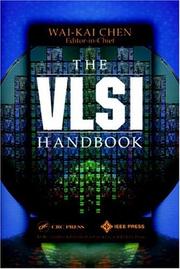
ISBN: 0849385938 Year: 2000 Publisher: Boca Raton, FL : New York, NY : CRC Press [Chemical Rubber Company], IEEE Press,
Abstract | Keywords | Export | Availability | Bookmark
 Loading...
Loading...Choose an application
- Reference Manager
- EndNote
- RefWorks (Direct export to RefWorks)
Integrated circuits --- Circuits intégrés à très grande échelle --- Very large scale integration. --- 621.382vl --- ASIC application specified IC --- BICMOS bipolar and C-MOS --- BJT bipolar junction transistor --- CMOS complementary metal oxide semiconductor --- FPGA field programmable gate arrays --- HDL hardware description language --- PLD programmable logic design --- SOI silicon on insulator --- SRAM static random access memory --- VHDL very high speed hardware description language --- VLSI very large scale integration --- algoritmen --- bipolaire transistoren --- elektronica --- elektrotechniek --- logisch ontwerpen --- microprocessoren --- ontwerpen --- simulatie --- testen --- versterkingstechniek --- Very large scale integration --- Circuits intégrés à très grande échelle --- Very large scale integration of circuits --- VLSI circuits --- Circuits intégrés à très grande échelle. --- Circuits intégrés à très grande échelle.

ISBN: 9780792377665 0792377664 9780306476877 9786610201709 1280201703 0306476878 Year: 2000 Publisher: Boston (Mass.) : Kluwer academic,
Abstract | Keywords | Export | Availability | Bookmark
 Loading...
Loading...Choose an application
- Reference Manager
- EndNote
- RefWorks (Direct export to RefWorks)
CHAPTER 6 Architecting Testbenches 221 Reusable Verification Components 221 Procedural Interface 225 Development Process 226 Verilog Implementation 227 Packaging Bus-Functional Models 228 Utility Packages 231 VHDL Implementation 237 Packaging Bus-Functional Procedures 238 240 Creating a Test Harness 243 Abstracting the Client/Server Protocol Managing Control Signals 246 Multiple Server Instances 247 Utility Packages 249 Autonomous Generation and Monitoring 250 Autonomous Stimulus 250 Random Stimulus 253 Injecting Errors 255 Autonomous Monitoring 255 258 Autonomous Error Detection Input and Output Paths 258 Programmable Testbenches 259 Configuration Files 260 Concurrent Simulations 261 Compile-Time Configuration 262 Verifying Configurable Designs 263 Configurable Testbenches 265 Top Level Generics and Parameters 266 Summary 268 CHAPTER 7 Simulation Management 269 Behavioral Models 269 Behavioral versus Synthesizable Models 270 Example of Behavioral Modeling 271 Characteristics of a Behavioral Model 273 x Writing Testbenches: Functional Verification of HDL Models Modeling Reset 276 Writing Good Behavioral Models 281 Behavioral Models Are Faster 285 The Cost of Behavioral Models 286 The Benefits of Behavioral Models 286 Demonstrating Equivalence 289 Pass or Fail? 289 Managing Simulations 292 294 Configuration Management Verilog Configuration Management 295 VHDL Configuration Management 301 SDF Back-Annotation 305 Output File Management 309 Regression 312 Running Regressions 313 Regression Management 314 Summary 316 APPENDIX A Coding Guidelines 317 Directory Structure 318 VHDL Specific 320 Verilog Specific 320 General Coding Guidelines 321 Comments 321 Layout 323 Syntax 326 Debugging 329 Naming Guidelines 329 Capitalization 330 Identifiers 332 Constants 334 334 HDL Specific Filenames 336 HDL Coding Guidelines 336 337 Structure 337 Layout.
Integrated circuits --- Computer hardware description languages. --- Langages de description de matériel informatique --- Circuits intégrés --- Verification. --- Vérification --- Computer aided design. --- Computer engineering. --- Computer hardware. --- Engineering. --- Integrated circuits - Verification. --- Systems engineering. --- Computer hardware description languages --- Electrical Engineering --- Electrical & Computer Engineering --- Engineering & Applied Sciences --- Verification --- Circuits and Systems. --- Computer Hardware. --- Electrical Engineering. --- Computer-Aided Engineering (CAD, CAE) and Design. --- Electronic circuits. --- Electrical engineering. --- Computer-aided engineering. --- CAE --- Engineering --- Electric engineering --- Electron-tube circuits --- Electric circuits --- Electron tubes --- Electronics --- Data processing --- Hardware verification --- Integrated circuit verification --- Verification of hardware --- Verification of integrated circuits --- Hardware description languages, Computer --- Languages, Computer hardware description --- Electronic digital computers --- Design and construction
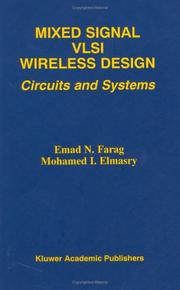
ISBN: 9780792386872 0792386876 9780306473074 9786610207909 1280207906 0306473070 Year: 2000 Publisher: Boston: Kluwer,
Abstract | Keywords | Export | Availability | Bookmark
 Loading...
Loading...Choose an application
- Reference Manager
- EndNote
- RefWorks (Direct export to RefWorks)
“Wireless is coming” was the message received by VLSI designers in the early 1990’s. They believed it. But they never imagined that the wireless wave would be coming with such intensity and speed. Today one of the most challenging areas for VLSI designers is VLSI circuit and system design for wireless applications. New generation of wireless systems, which includes multimedia, put severe constraints on performance, cost, size, power and energy. The challenge is immense and the need for new generation of VLSI designers, who are fluent in wireless communication and are masters of mixed signal design, is great. No single text or reference book contains the necessary material to educate such needed new generation of VLSIdesigners. There are gaps. Excellent books exist on communication theory and systems, including wireless applications and others treat well basic digital, analog and mixed signal VLSI design. We feel that this book is the first of its kind to fill that gap. In the first half of this book we offer the reader (the VLSI designer) enough material to understand wireless communication systems. We start with a historical account. And then we present an overview of wireless communication systems. This is followed by detailed treatment of related topics; the mobile radio, digital modulation and schemes, spread spectrum and receiver architectures. The second half of the book deals with VLSI design issues related to mixed-signal design. These include analog-to-digital conversion, transceiver design, digital low-power techniques, amplifier design, phase locked loops and frequency synthesizers.
Integrated circuits --- Wireless communication systems --- Radio circuits --- Cellular telephones --- Circuits intégrés à très grande échelle --- Transmission sans fil --- Circuits radio --- Very large scale integration --- Design and construction. --- Equipment and supplies --- Conception et construction --- Cell phones --- Design and construction --- Systems engineering. --- Computer engineering. --- Circuits and Systems. --- Electrical Engineering. --- Electronic circuits. --- Electrical engineering. --- Electric engineering --- Engineering --- Electron-tube circuits --- Electric circuits --- Electron tubes --- Electronics --- Communication systems, Wireless --- Wireless data communication systems --- Wireless information networks --- Wireless telecommunication systems --- Telecommunication systems --- Very large scale integration&delete& --- Equipment and supplies&delete& --- Integrated circuits - Very large scale integration - Design and construction --- Wireless communication systems - Design and construction --- Radio circuits - Design and construction --- Cell phones - Equipment and supplies - Design and construction --- Cell telephones --- Cellphones --- Cellular phones --- Cellular radio --- Mobile phones --- Mobiles (Telephones) --- Phones, Cell --- Telephones, Cell --- Wireless phones --- Radio --- Telephone --- Transmitter-receivers
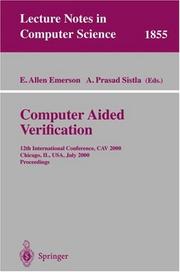
ISSN: 03029743 ISBN: 3540677704 9783540677703 3540450475 Year: 2000 Volume: 1855 Publisher: Berlin: Springer,
Abstract | Keywords | Export | Availability | Bookmark
 Loading...
Loading...Choose an application
- Reference Manager
- EndNote
- RefWorks (Direct export to RefWorks)
This volume contains the proceedings of the 12th International Conference on Computer Aided Verification (CAV 2000) held in Chicago, Illinois, USA during 15-19 July 2000. The CAV conferences are devoted to the advancement of the theory and practice of formal methods for hardware and software verification. The conference covers the spectrum from theoretical foundations to concrete applications, with an emphasis on verification algorithms, methods, and tools together with techniques for their implementation. The conference has traditionally drawn contributions from both researchers and practitioners in academia and industry. This year 91 regular research papers were submitted out of which 35 were accepted, while 14 brief tool papers were submitted, out of which 9 were accepted for presentation. CAV included two invited talks and a panel discussion. CAV also included a tutorial day with two invited tutorials. Many industrial companies have shown a serious interest in CAV, ranging from using the presented technologies in their business to developing and marketing their own formal verification tools. We are very proud of the support we receive from industry. CAV 2000 was sponsored by a number of generous andforward-lookingcompaniesandorganizationsincluding:CadenceDesign- stems, IBM Research, Intel, Lucent Technologies, Mentor Graphics, the Minerva Center for Verification of Reactive Systems, Siemens, and Synopsys. The CAV conference was founded by its Steering Committee: Edmund Clarke (CMU), Bob Kurshan (Bell Labs), Amir Pnueli (Weizmann), and Joseph Sifakis (Verimag).
Computer software --- Integrated circuits --- Logiciels --- Circuits intégrés --- Verification --- Congresses. --- Vérification --- Congrès --- Computer science. --- Special purpose computers. --- Software engineering. --- Computer logic. --- Mathematical logic. --- Artificial intelligence. --- Computer Science. --- Software Engineering/Programming and Operating Systems. --- Logics and Meanings of Programs. --- Software Engineering. --- Mathematical Logic and Formal Languages. --- Special Purpose and Application-Based Systems. --- Artificial Intelligence (incl. Robotics). --- Logic design. --- Circuits intégrés --- Vérification --- Congrès --- Design, Logic --- Design of logic systems --- Computer software engineering --- Informatics --- Engineering --- Science --- Digital electronics --- Electronic circuit design --- Logic circuits --- Machine theory --- Switching theory --- Artificial Intelligence. --- AI (Artificial intelligence) --- Artificial thinking --- Electronic brains --- Intellectronics --- Intelligence, Artificial --- Intelligent machines --- Machine intelligence --- Thinking, Artificial --- Bionics --- Cognitive science --- Digital computer simulation --- Electronic data processing --- Logic machines --- Self-organizing systems --- Simulation methods --- Fifth generation computers --- Neural computers --- Special purpose computers --- Computers --- Algebra of logic --- Logic, Universal --- Mathematical logic --- Symbolic and mathematical logic --- Symbolic logic --- Mathematics --- Algebra, Abstract --- Metamathematics --- Set theory --- Syllogism --- Computer science logic --- Logic, Symbolic and mathematical --- Computer software - Verification - Congresses --- Integrated circuits - Verification - Congresses --- Logic, Symbolic and mathematical. --- Computers, Special purpose.
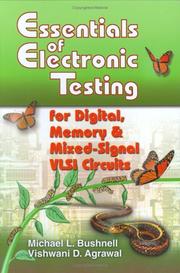
ISBN: 0792379918 9780792379911 9780306470400 0306470403 1601190174 1280206098 9786610206094 1475781423 Year: 2000 Volume: 17 Publisher: Boston: Kluwer,
Abstract | Keywords | Export | Availability | Bookmark
 Loading...
Loading...Choose an application
- Reference Manager
- EndNote
- RefWorks (Direct export to RefWorks)
The modern electronic testing has a forty year history. Test professionals hold some fairly large conferences and numerous workshops, have a journal, and there are over one hundred books on testing. Still, a full course on testing is offered only at a few universities, mostly by professors who have a research interest in this area. Apparently, most professors would not have taken a course on electronic testing when they were students. Other than the computer engineering curriculum being too crowded, the major reason cited for the absence of a course on electronic testing is the lack of a suitable textbook. For VLSI the foundation was provided by semiconductor device technology, circuit design, and electronic testing. In a computer engineering curriculum, therefore, it is necessary that foundations should be taught before applications. The field of VLSI has expanded to systems-on-a-chip, which include digital, memory, and mixed-signal subsystems. To our knowledge this is the first textbook to cover all three types of electronic circuits. We have written this textbook for an undergraduate “foundations” course on electronic testing. Obviously, it is too voluminous for a one-semester course and a teacher will have to select from the topics. We did not restrict such freedom because the selection may depend upon the individual expertise and interests. Besides, there is merit in having a larger book that will retain its usefulness for the owner even after the completion of the course. With equal tenacity, we address the needs of three other groups of readers.
Integrated circuits --- Digital integrated circuits --- Mixed signal circuits --- Semiconductor storage devices --- Very large scale integration --- Testing --- -Integrated circuits --- -Semiconductor storage devices --- -Semiconductor memories --- Computer storage devices --- Semiconductors --- Circuits, Mixed signal --- Mixed analog-digital integrated circuits --- Mixed mode integrated circuits --- Very large scale integration of circuits --- VLSI circuits --- Digital electronics --- Very large scale integration. --- Circuits intégrés numériques --- Digital integrated circuits -- Testing. --- Integrated circuits -- Very large scale integration -- Testing. --- Mixed signal circuits -- Testing. --- Semiconductor storage devices -- Testing. --- Engineering. --- Computers. --- Computer-aided engineering. --- Electrical engineering. --- Electronics. --- Microelectronics. --- Electronic circuits. --- Electronics and Microelectronics, Instrumentation. --- Theory of Computation. --- Circuits and Systems. --- Electrical Engineering. --- Computer-Aided Engineering (CAD, CAE) and Design. --- Testing. --- Semiconductor memories --- Chips (Electronics) --- Circuits, Integrated --- Computer chips --- Microchips --- Very large scale integration&delete& --- Information theory. --- Systems engineering. --- Computer engineering. --- Computer aided design. --- Electronic circuits --- Microelectronics --- CAE --- Engineering --- Electric engineering --- Electron-tube circuits --- Electric circuits --- Electron tubes --- Electronics --- Automatic computers --- Automatic data processors --- Computer hardware --- Computing machines (Computers) --- Electronic brains --- Electronic calculating-machines --- Electronic computers --- Hardware, Computer --- Computer systems --- Cybernetics --- Machine theory --- Calculators --- Cyberspace --- Microminiature electronic equipment --- Microminiaturization (Electronics) --- Microtechnology --- Miniature electronic equipment --- Electrical engineering --- Physical sciences --- Data processing --- Integrated circuits - Very large scale integration - Testing --- Digital integrated circuits - Testing --- Mixed signal circuits - Testing --- Semiconductor storage devices - Testing
| Listing 1 - 10 of 10 |
Sort by
|

 Search
Search Feedback
Feedback About UniCat
About UniCat  Help
Help News
News